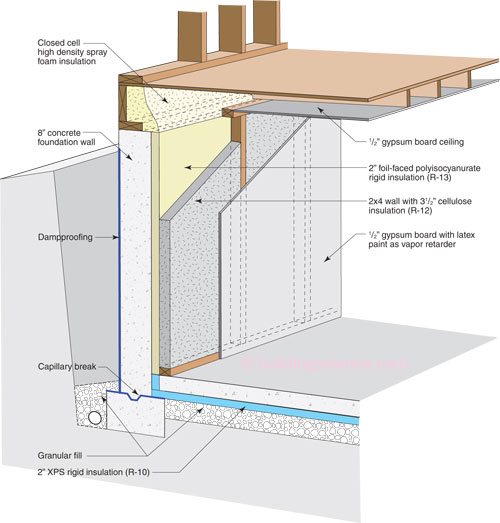This construction uses 2" foil-faced polyisocynaurate insulation against the concrete foundation and a 2x4 framed wall with R-12 cellulose insulation in the stud space. The slab is insulated with 2" XPS rigid insulation under slab and the rim joist is insulated with closed cell high density spray foam insulation.
Foundation Wall
- Free draining backfill
- Dampproofing to grade
- Concrete foundation wall (over a capillary break on the concrete footing)
- 2" foil-faced polyisocyanurate rigid insulation
- 2x4 frame wall with R-12 cellulose cavity insulation
- Interior gypsum wall board with vapor retarder paint
Foundation Slab
- Concrete foundation slab
- 6 mil polyethylene vapor barrier under slab
- 2" XPS rigid insulation under slab
- 4” stone pad (no fines)
- Undisturbed/ native soil
Thermal Control
This wall system has an installed insulation R-value of R-25 which is only slightly lower based on the parallel path calculation method which accounts for the wall framing assuming 24” on center. This basement combined with R-10 under the slab and R-10 thermal break results in an annual predicted heating energy loss of 15.45 MBtus.
Moisture Control
The water vapor diffusion and capillary wicking are controlled by 2” of PIC insulation assuming that the PIC is well sealed to the concrete. This wall system was not hygrothermally simulated since it will not experience any moisture related issues. The foil face on the polyisocyanurate will not allow vapor diffusion from the concrete foundation, and the increased R-value of PIC compared to XPS will increase the condensation surface temperature compared to High-R Foundation 8 and High-R Foundation 14, resulting in decreased condensation potential.
Constructability and Cost
Fiberglass batt insulation could be used in the place of cellulose to decrease the cost of the assembly.
Other Considerations
High-R Foundation 8 is one of the simplest methods of minimizing the moisture risk and saving energy which also allows the basement to be finished. It is possible to use other air permeable insulations instead of cellulose including fiberglass batt or spray fiberglass.
Reference
Mitalas, G.P., Calculation of Basement Heat Loss, National Research Council Canada.

